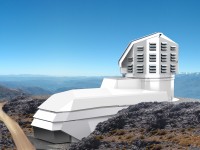All the sky – all the time

All the sky – all the time: UK astronomers debate involvement in the Large Synoptic Survey Telescope.
Astronomers will discuss the case for UK involvement in the Large Synoptic Survey Telescope project (LSST) on Monday 23 June at the National Astronomy Meeting in Portsmouth. The LSST will be sited at Cerro Pachón in the Chilean Andes and will have a primary mirror 8.4 metres in diameter, making it one of the largest single telescopes in the world, as well as the world’s largest digital camera, comprising 3.2 billion pixels. It will achieve first light in 2020 and its main sky survey will begin in 2022.
Uniquely, the LSST will be able to see a large patch of sky, 50 times the area of the full Moon, in each snapshot. Also it will move quickly, taking more than 800 images each night and photographing the entire southern sky twice each week.
The greatest movie ever made?
A powerful data system will compare new images with previous ones to detect changes in brightness and position of all the objects detected. As just one example, this could be used to detect and track potentially hazardous asteroids that might impact the Earth and cause significant damage. Billions of galaxies, stars and solar system objects will be seen for the first time and monitored over 10 years. Ultimately, the goal is to record the greatest movie ever made.
LSST is a partnership between public and private organizations and is led by the US. The unique scientific opportunities presented by LSST have led to the formation of a consortium of astronomers from more than 30 UK universities to seek funding from the Science and Technology Facilities Council to support UK participation in the project.
The LSST:UK Project Scientist, Sarah Bridle from the University of Manchester, said, “Every night LSST will provide millions of alerts signalling objects that have changed on the sky. We want to compare these to earlier observations and other data including that from the Square Kilometer Array, to find out what they are – from exotic superluminous supernovae to colliding asteroids. Over the whole of the next decade, LSST will also measure the approximate distances to billions of galaxies, which will allow us to learn the nature of the mysterious dark energy that seems to be making the Universe expand faster and faster."
Steve Kahn, the LSST Director added, "I am delighted that the UK is seriously considering participation in LSST. The UK's traditional strength in survey astronomy and the pioneering work done through the Zooniverse project to engage the public make it a natural partner for us. We would greatly value the contribution that the UK astronomy community would bring to enable the success of LSST."
"LSST offers tremendous opportunities for the training of young researchers in the computational skills needed to meet the 'Big Data' challenges prevalent in both public and private sectors today. LSST is already driving research into the management and manipulation of multi-Petabyte datasets in the US and we are sure that our involvement in the project will stimulate similar developments in academia and industry in the UK." The LSST:UK Project Leader, Bob Mann, Institute for Astronomy, University of Edinburgh
Science themes
The science themes of the LSST encompass astronomy, physics, chemistry, earth science, space science, mathematics, technology and computing, and the discoveries made by the LSST will be used to construct educational materials that will be freely available to schools and the public. Andrew Norton from the Open University, the LSST:UK Education and Public Outreach Coordinator, said, "The LSST will allow us to see the night sky changing in front of our eyes and everyone can get involved to understand how the Universe works. The LSST will really show us what a dynamic place the Universe is."
Citizen science
The LSST will provide unprecedented access to data, allowing for new kinds of citizen science and discovery. In recent years, the Zooniverse project has pioneered citizen science investigations of data in astronomy, enabling more than one million members of the public to explore data in projects such as Galaxy Zoo and Planet Hunters. The Zooniverse's Robert Simpson, the LSST:UK Public Data Coordinator from Oxford University, noted, "The citizen science and amateur astronomy communities around the UK, and the world, will be able to access the amazing data that comes out of the LSST. The potential for discovery will be on a scale we haven't seen before."
The Large Synoptic Survey Telescope (LSST)
The LSST will be sited at Cerro Pachón in the Chilean Andes at an altitude of 2715m. The primary mirror diameter is 8.4m, making it one of the largest single telescopes in the world. It also contains secondary and tertiary mirrors with diameters of 3.4m and 5.2m respectively. It will contain the world’s largest digital camera, comprising 3.2 billion pixels (3200 Mpix) in a circular array of 189 detectors. The size of the camera detector is 63cm across. It will generate 30 Terabytes (30,000 Gb) of data every night.
It will achieve first light in 2020 and its main sky survey will begin in 2022. The scale of the technical challenges involved in storing and analyzing LSST’s data are daunting, and researchers are already starting work in earnest on the project.
Learn more at www.lsst.org.

